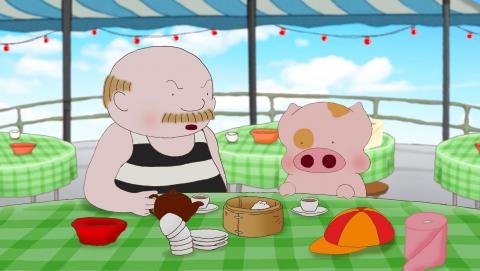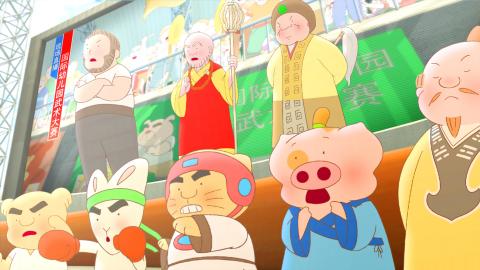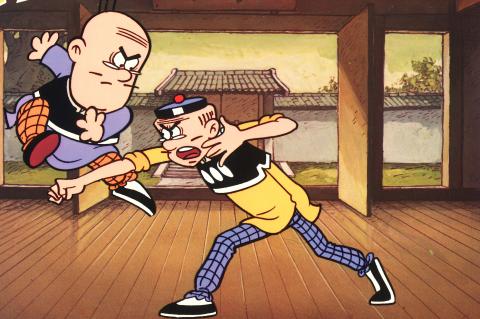The history and vicissitudes of animation in Taiwan and Hong Kong are being presented at an exhibition at Taipei’s Huashan 1914 Creative Park and New Taipei City’s Fuzong 15 (府中15) until the beginning of next month.
Fifty Years of Hong Kong and Taiwan Animation (香港台灣動畫五十年大展) features a series of exhibitions, talks and seminars as well as a lineup of 10 feature-length animated films and 25 short works.
As part of Hong Kong Week (香港週), organized by the Hong Kong-Taiwan Cultural Co-operation Committee and run in association with the Hong Kong Economic, Trade and Cultural Office in Taiwan, the event is the first of its kind to spotlight the industry, particularly the past exchanges between animators from Taiwan and Hong Kong.

Photo courtesy of Hong Kong Arts Center
“We hope visitors find the festival entertaining while learning one or two things about history,” says festival curator Neco Lo (盧子英), who is also a respected animation artist, educator and historian in Hong Kong.
COLLABORATION
Older Master Cute (七彩卡通老夫子) is among the more significant films that will be shown. Released in 1981, the cinematic adaption of the immensely popular comic series Old Master Q was Hong Kong’s first feature-length animated film. It was also a successful collaboration between animation professionals in Taiwan and Hong Kong.

Photo courtesy of Hong Kong Arts Center
Lo says that while Taiwan’s animation industry thrived on handling subcontract work from US companies in the 1970s, Hong Kong didn’t develop one because of the territory’s high rent and lack of talent.
“When they decided to make the Older Master Cute film in 1978, there were only around 30 animation artists working in Hong Kong... and they were all very busy. Then they found out that Taiwan already had a sound industry,” Lo says.
The combination of Taiwanese talent and money from Hong Kong resulted in the film becoming a huge box-office success, especially in Taiwan where it raked in NT$100 million.

Photo courtesy of Hong Kong Arts Center
Around the same time, Hong Kong animation artist Yu Wei-cheng (余為政) helped to set up Taiwan’s Wang Film Production (宏廣動畫), once the largest animation production company in the world, and worked with local animators to produce the rarely seen Uncle Niou’s Great Adventure (牛伯伯與牛小妹大破鑽石城) in 1982, which will be shown at the festival.
Also on the lineup is Hong Kong’s hugely popular McDull (麥兜) series featuring the much beloved comic book character of the same name.
Edith Chiu (趙嘉薇), program manager of the Hong Kong Arts Center (香港藝術中心), the event’s organizer, says that the popularity of the McDull series lies in the fact that it is deeply rooted in local life and culture.
“Apart from the familiar nooks and crannies of Hong Kong and its hustle and bustle, the cartoon characters adopt a local style of speaking that only Hong Kongers would truly appreciate,” she says.
connecting with local audiences
Even with the phenomenal success of Older Master Cute, there have only been a dozen or so full-length feature films made in Hong Kong over the past 30 years. Taiwan has made slightly more, but few are memorable. Limited capital and financial resources are part of the reason. And though animators in both Taiwan and Hong Kong are technically proficient, the industry itself lacks strength in scriptwriting, character design and planning at the pre-production stage.
Animation created in Taiwan can resonate and connect with local audiences in a way that Hollywood mega-budget productions cannot, Chiu says.
“In some of the locally produced films, we can actually see how people in Hong Kong live their lives, or how Taiwanese face and deal with their history ... They can address local issues, reflect local customs and ways of life,” she says.
Lo says that a local production needs to find acceptance in its own home market first.
“What kind of animation is it if local audiences aren’t interested? Focusing on the local market is the most basic aspect for future success, not trying to become an equivalent to Pixar,” Lo says.
Echoing Lo and Chiu’s sentiments, Jay Shih (石昌杰), a professor in the Department of Multimedia and Animation Arts at National Taiwan University of the Arts, says Taiwanese animators have been struggling with full-length features that local audiences can identify with. Without a commercially successful production, investors are reluctant to put money into the business.
Shih cites McDull from Hong Kong and China’s Pleasant Goat (喜羊羊) as examples of foreign imports that are well known locally. However, few cartoon characters created by Taiwanese interest local audiences.
“When asked to name a good Taiwanese animation, my students always answer: Grandma and Her Ghosts (魔法阿媽). But that film came out in 1998,” Shih says, referring to director Wang Hsiao-ti’s (王小棣) 1998 animation about a boy and his ghost-busting grandmother.
PRESERVING HISTORY
For the past two decades, the Hong Kong Arts Center has promoted comic and animation art through film screenings, exhibitions, workshops, forums and other activities Chiu says. Last year, the non-profit organization collaborated with Hong Kong’s Urban Renewal Authority to establish Comix Home Base (動漫基地), a space dedicated to comic and animation art.
In recent years, efforts to preserve the past have been made through exhibitions curated by Lo, who, as a veteran animation artist working in both film and TV, has accumulated a vast archive of animation history.
“The exhibitions have enabled us to track down older works. Though many are lost, we have been lucky to preserve a few,” Lo says.
For the Taipei show, organizers put together a rare exhibition showcasing more than 200 original manuscripts, production cels, storyboards and sketches for animated films and television works in Hong Kong from the 1960s to the present.
Looking back to Taiwan, its animated past is likely to remain buried in someone’s storeroom as the nation has yet to establish an institute or an archive dedicated to comics and animation.
“Compared to Hong Kong, Taiwan does appear to have less memory,” Shih laments.
Apart from film screenings and the exhibition, a series of seminars and lectures will be held today and tomorrow by animation artists and industry professionals — including Lo, Yu and Shih — from Taiwan and Hong Kong. For complete details in Chinese and English visit www.hongkongweek-taiwan.hk/tc.

The unexpected collapse of the recall campaigns is being viewed through many lenses, most of them skewed and self-absorbed. The international media unsurprisingly focuses on what they perceive as the message that Taiwanese voters were sending in the failure of the mass recall, especially to China, the US and to friendly Western nations. This made some sense prior to early last month. One of the main arguments used by recall campaigners for recalling Chinese Nationalist Party (KMT) lawmakers was that they were too pro-China, and by extension not to be trusted with defending the nation. Also by extension, that argument could be

Aug. 4 to Aug. 10 When Coca-Cola finally pushed its way into Taiwan’s market in 1968, it allegedly vowed to wipe out its major domestic rival Hey Song within five years. But Hey Song, which began as a manual operation in a family cow shed in 1925, had proven its resilience, surviving numerous setbacks — including the loss of autonomy and nearly all its assets due to the Japanese colonial government’s wartime economic policy. By the 1960s, Hey Song had risen to the top of Taiwan’s beverage industry. This success was driven not only by president Chang Wen-chi’s

Last week, on the heels of the recall election that turned out so badly for Taiwan, came the news that US President Donald Trump had blocked the transit of President William Lai (賴清德) through the US on his way to Latin America. A few days later the international media reported that in June a scheduled visit by Minister of National Defense Wellington Koo (顧立雄) for high level meetings was canceled by the US after China’s President Xi Jinping (習近平) asked Trump to curb US engagement with Taiwan during a June phone call. The cancellation of Lai’s transit was a gaudy

The centuries-old fiery Chinese spirit baijiu (白酒), long associated with business dinners, is being reshaped to appeal to younger generations as its makers adapt to changing times. Mostly distilled from sorghum, the clear but pungent liquor contains as much as 60 percent alcohol. It’s the usual choice for toasts of gan bei (乾杯), the Chinese expression for bottoms up, and raucous drinking games. “If you like to drink spirits and you’ve never had baijiu, it’s kind of like eating noodles but you’ve never had spaghetti,” said Jim Boyce, a Canadian writer and wine expert who founded World Baijiu Day a decade